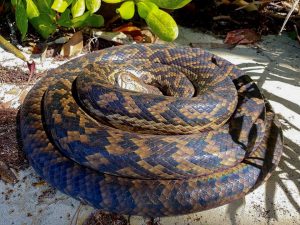Critter Corner – Amethystine Python (Australian form)
#CritterCorner – Ranked #6 on the list of largest snakes in the world, the Amethystine Python (Australian form), also known as the Australian Scrub Python (Simalia kinghorni) is the largest native snake in Australia. The term ‘Amethystine pythons’ was previously used as the type species for a group of five snakes that scientists believed were subspecies of amethystine pythons. They classified them all under the Morelia genus until a group of biologists delved deeper, using genetic sequencing and morphology. Their research revealed that they are genetically distinct and deserving of full species status. What they wound up with were five different species, and moved them to the Simalia genus. The pythons specific and common names are references to their scales that are reminiscent of an amethyst gemstone in the right light. Australians call them scrub pythons and in some areas of New Guinea, they’re known as sanca permata.
Amethystine pythons can be found in Indonesia and Papua New Guinea (Simalia amethistina – Amethystine python), as well as Australia (Simalia kinghorni). Until 2000, the larger Simalia kinghorni was generally considered a subspecies of Simalia amethistina

Photo courtesy of Emily Silverstone (RR’s Daintree Supporters Coordinator)
When measured by length or weight, they are ranked #6 on the list of largest snakes in the world. A typical adult Australian Scrub Python will measure around 2 to 4 m. Females generally weigh around 15 kg, while males are much smaller weighing in at an average of 5.1 kg. Some exceptional specimens have been confirmed to weigh over 30 kg!
They prefer warm, humid habitats with good water sources and Queensland’s population resides primarily in the rainforest.
Some larger Australian and Papuan specimens catch and eat wallabies, and cuscus, waiting by creek and river banks for prey seeking drinking water, but the general diet of the amethystine python consists of birds, bats, rats, possums, and other small mammals.
The Australian Scrub Python is listed as ‘Least concern (LC) – Stable’ on the IUCN Red List of Threatened Species.
Wondering where the name Amethystine Python comes from? Look closely, and in the right light, and you’ll see this beautiful critter shines like an amethyst gemstone.
Fun Fact: These beautiful snakes have infra-red or heat-sensitive labial pits that allow them to detect, stalk and strike prey accurately in the dark.
If you’d like a visual of just how big these snakes are compared to a full-grown human, check out this Facebook post from our friends at Destination Daintree
Information Sourced from Wikipedia, Australian Geographic and Dept. of Agriculture, Water & Environment
Want more good Rainforest news in your life?
Subscribe to our eNews | Follow us on Instagram | Like us on Facebook | Subscribe to our YouTube channel
Help Protect Rainforests Forever
Donate to Protect Rainforests Forever | Become a Rainforest Guardian for as little as $2 a month | Partnership Options

